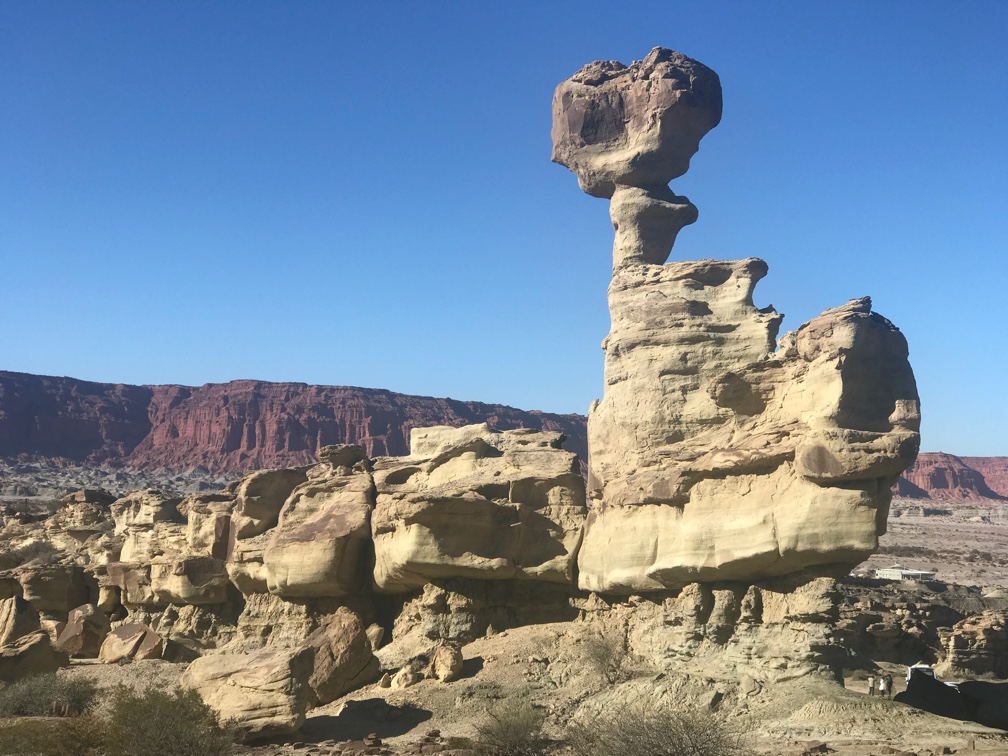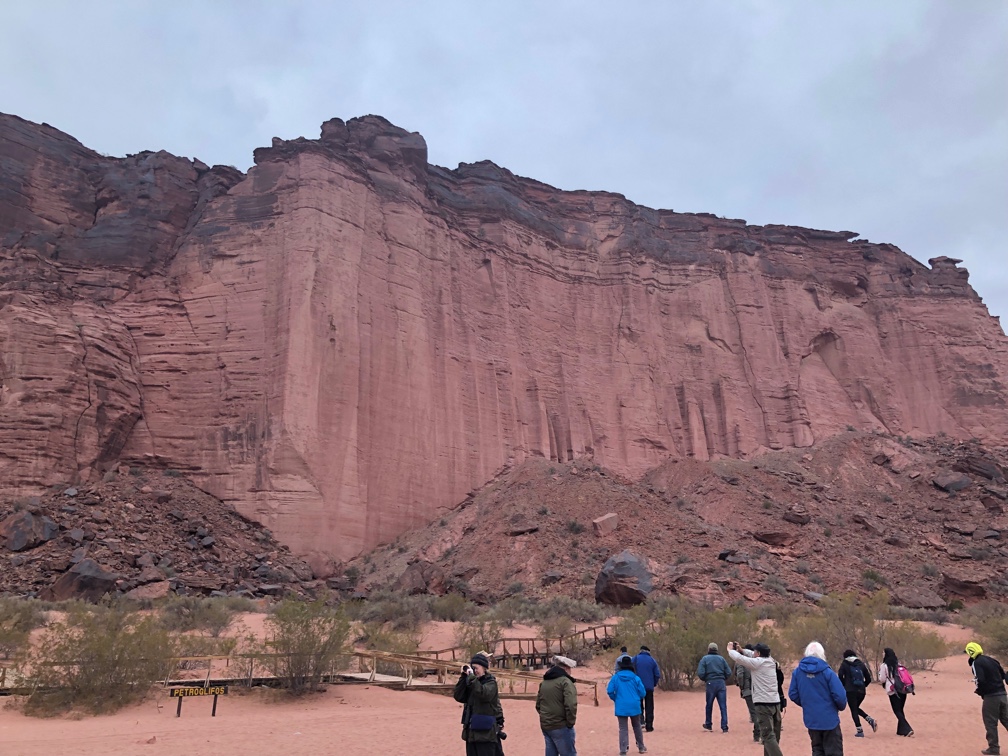Wednesday, July 3
After taking our departure from Hualta Picum Apart Hotel, we drove east along Ruta 150 toward the UNESCO World Heritage Sites of Ischigualasto and Talampaya parks. This whole part of San Juan province is Argentina Highways-ready red rock glory, and occasionally bursts into Photoshopped hallucination.
The east side of the Andes have had the fortune, in the last 300 million years, to be a large sea, where sediments settled and dinosaurs drowned, as a result of which there are thousands of meters of sedimentary rock all through western Argentina in a variety of hues and with a fossil record from the early Triassic to our own time. One of the earliest root dinosaurs known, Eodromaeus murphi, lived here. It has been carefully reconstructed in the visitors center. The current fashion is to show the dinosaurs with the flashy colors they probably had. Used to be they were all gray green. None of this is as good as the Natural History museum in Vienna, which has animatronics. Austria has a higher budget. I expect that the Chinese paleontologic sites will be the first to supply AR helmets so you can wander among the giant ferns. Unless biotech advances faster. Ischigualasto refers to itself as “Triassic Park”.
The manner of tourism in Ischigualasto is caravans of private vehicles. They really don’t want the whole thing overwhelmed like Yosemite. Tourism is a challenge. Every hour or so, thirty cars will line up behind a guide car, and follow it in a four hour loop around the park, looking at artistic features and listening to lectures from the guide in the main car. The lectures are all in Spanish, but you can get the idea even knowing a modicum of restaurant Spanish, because you already know and see.
It works fairly well. The only real disappointment, I would say, is the concretions that you see pictured if you Google Image Search <Concretions Ischigualasto>. You might be expecting big stones as on the coast of New Zealand. But when you get there, the moment is like the lowering of the Stonehenge in Spinal Tap. They are about like croquet balls. In fact, the picture of this geological feature that Alamy has for sale is indexed: “Cancha de Bochas”. Bocce balls.
On the trail to the bocce balls, there are fields of even tinier pebbles, all round, which photographed from a suitably low angle, except you aren’t allowed off the wooden trails, would look the same, posed with the tiny woven dolls you see hanging from Peruvian hats.
There is also a museum honoring one of the paleontologists who worked here. In the atrium is a fossil that hasn’t been dug out entirely, or colorized. It’s good to see the raw data.
There are lots of eroded pillars named for their appearance. Mushrooms, Sphinxes, that sort of thing. At least they don’t carve the names into the rock, as have the managers of Shi Lin, near Kunming. A yellow monument named Submarine used to have two towers, but one has collapsed.

Ischigualasto is also where the muffler pipe broke on our rented Renault Logan.
That was an issue. We dragged along to the Bocce ball place, and then the guide lady used her radiophone to call the main ranger, who sent out two mechanics with some baling wire. That kept it from dragging on the ground, at least when we were driving forward, and we had an unmuffled drive back to San Agustín, with occasional scraping as the pipe hanging off the engine touched the ground.
We went to the Triassico restaurant in San Agustín. The decor is Ambitious: a stairway with a tyrannosaurus skeleton bannister, many statuettes leaping out of the walls.
Thursday, July 4
In the morning, we called SiXT emergency services, who encouraged us to get it fixed. Google found an auto mechanic, who said, nope, try this guy, and that guy said, nope, try this guy, and the third guy guided us over his work pit and got out his torch and welded the muffler back together, while we looked at his bird collection in cages on the hood of a wrecked car in his junkyard. Other birds approached to get the scattered seeds. We gave him 500 pesos but didn’t get a receipt because it seemed minor ($12).
It was still only noon. So we went to the second park, Talampaya. This tour was on a bus. It was cloudy, and the red of the colored rocks didn’t jump out so much. But Cañon de Talampaya was impressive. Four km of 150m cliffs. “The Chimney” was a cylinder in one of the cliff walls. There were also monuments in that formation, all wind and water eroded to shapes called “Monk” and “Cathedral”. They served Torrontes at a stop in the canyon. We also saw a bunch of Andean condors, which everyone wanted to watch, even more than the dull red rocks. The tall cliffs give the birds their desired habitat.

We got back to the visitor center about sunset. The sun had peeked out a bit from the overcast, and illuminated the cliffs in Argentina Highway orange. The museum cafe was still open. I suggested that museum food might be just as good as small town food, and I think it was. Empanadas, of course. This was our introduction to locro, the cold-weather national dish. I looked online for a recipe just now, and the first recipe I found had nothing in common with any of the locros we’ve had, so I think the only nonvariant part of locro is that it is warm and thick.
We drove back to San Agustín after dark.